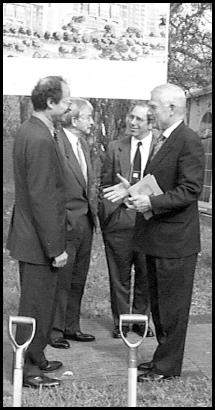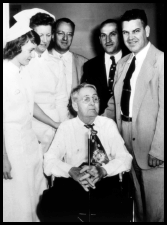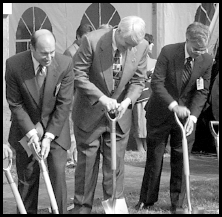 |
Future . . . In the foreground, NIH director Harold Varmus (left) converses with Sen. Mark Hatfield, for whom the Mark O. Hatfield Clinical Research Center is named. In the background, architect Bob Frasca (left) chats with Clinical Center director John Gallin. Behind and above them all is a drawing of the new CRC, expected to be completed in 2002. A few minutes earlier, as the speech-making inside a very large adjacent tent was coming to an end, Varmus read the plaque that will grace the new facility and that recognizes Senator Hatfield for "his deep and abiding commitment to medical research throughout his years in Congress," where he served in the Senate for 30 years and chaired the appropriations committee for eight before retiring at the end of the last session. Alluding to his own mortality, the senator asked only that the NIH director and everyone else involved in bringing the new CRC to life "please hurry." The assemblage then stepped lively out of the tent to the groundbreaking as the Walt Whitman High School Jazz Ensemble set the pace. |
. . . And Past Among the archival slides NCI's Alan Rabson displayed during his talk at the NIH Research Festival restrospective was this one on the right of the first patient admitted to the Clinical Center: On July 6, 1953, Charles Meredith (seated), a 67-year-old farmer with prostate cancer, passed through the new CC portals to be placed on a hormone therapy protocol by his physician, NCI's Roy Hertz (second from right). Also on hand (left to right) were Clinical Center nurses Nadine Luxmore and Elizabeth Walker, NCI scientific director Bo Mider, and NCI director Rod Heller. Nurses in the fifties, Rabson noted in his talk, were essentially nameless but would not be at the new Clinical Research Center or anywhere else, thanks to the work of nurses like NINR's director Pat Grady and new scientific director Annette Wysocki. |
 |
